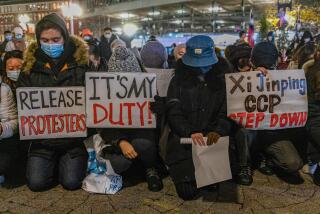Historic Beijing Square Scene of Much Tumult
- Share via
BEIJING — Tian An Men Square, a 100-acre paved expanse in the center of Beijing, has witnessed some of the most tumultuous and solemn scenes in modern Chinese history.
The square, extending southward from Tian An Men, or Gate of Heavenly Peace, from which it takes its name, has been the scene of rallies and demonstrations since it emerged in haphazard fashion 90 years ago from the ruins of old imperial ministries.
During imperial times the area was a walled forecourt to the Forbidden City, residence of China’s emperors, containing ministry offices. Western punitive military actions in 1860 and 1900 damaged the buildings, and eventually a square evolved.
The square today contains some of the most revered symbols of Communist China--the mausoleum of Mao Tse-tung and the Monument to the People’s Heroes, honoring the party’s struggle to power from its founding in 1921 to its victory in 1949.
Mao Proclaimed Republic
From the medieval ramparts of the gate on its north side, Mao proclaimed the People’s Republic of China and hoisted its red-and-gold five-star flag on Oct. 1, 1949. His portrait, a world-famous sight, hangs on the front wall of the gate, a red-painted brick building with a sweeping pagoda roof.
The square’s location and size have made it a natural venue for mass demonstrations throughout its existence.
On May 4, 1919, students outraged by the cession of Chinese territory to Japan as part of the post-World War I settlement held a mass rally, launching an important patriotic movement.
Anti-Japanese protests were held in 1926 and 1935, the latter starting the resistance to Japanese aggression in China.
The square saw huge staged demonstrations during the Cultural Revolution from 1966 to 1976.
In 1976, the square was the site of mass mourning rallies honoring Premier Chou En-lai, who died early that year. Memorial wreaths and placards were placed on the monument but were removed by officials.
Angered by that action, 100,000 protesters clashed with security forces April 5, 1976, until the square was cleared in mid-evening.
More to Read
Sign up for Essential California
The most important California stories and recommendations in your inbox every morning.
You may occasionally receive promotional content from the Los Angeles Times.












